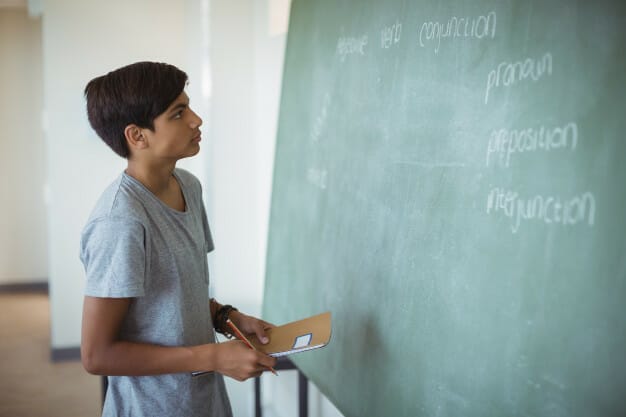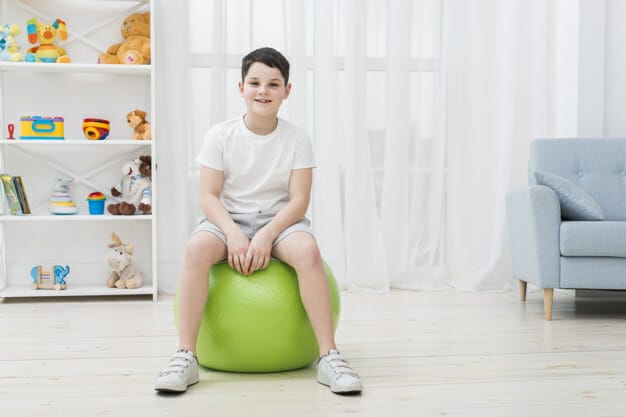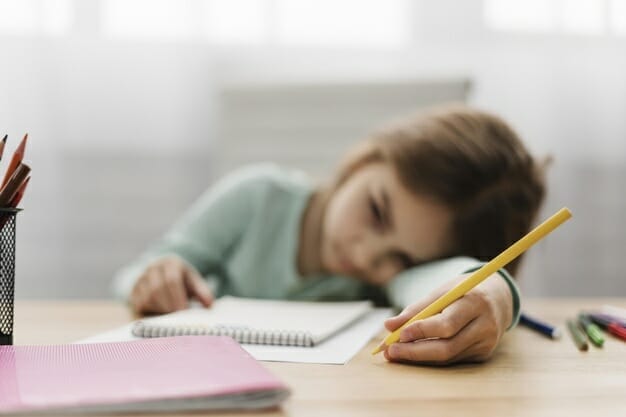Allyson Charette, MS, OTR/L Occupational Therapist
With distance learning and classes being held through online platforms, children are finding themselves sitting, often in the same position, for an extended amount of time throughout their day. According to the Centers for Disease Control and Prevention (2018), children 8-10 years of age are spending 6 hours a day in front of a screen for leisure and entertainment, and this statistic does not account for the recent increase in screen time due to remote learning. Even though we are told that limiting screen time is best, the current public health requirements related to social and academic distancing render this more difficult to achieve than ever before. Thus, school-age children are spending significantly more time sitting, and have less time (or space) for needed movement breaks throughout the day to recharge their minds and bodies.
However, there are simple ways in which we can increase the opportunities for children to move and use their bodies within the distance learning experience! Let’s consider how various seated positions and other environmental modifications can be incorporated throughout their day. These changes will simultaneously engage use of the postural muscles/core, increase attention, activate sensory systems (targeting the proprioceptive, tactile, and vestibular systems), improve motor planning skills, improve static/dynamic balance, and increase endurance. Research exploring short physical activity breaks and changes in body position demonstrates a positive correlation between movement breaks and improved cognitive skills, attitude, attention, academic behaviors, and academic achievement (Centers for Disease Control and Prevention, 2010).
We are used to the typical position for doing school work, where our body is seated upright in a chair with our feet supported (ankles, knees, and hips all at 90 degrees). However, there are many other positions your child can do throughout their school day that work on their fine motor skills, gross motor skills, and improve body posture! Something that was ingrained in me throughout my education to become an Occupational Therapist is the influence that proximal stability (or strong core and shoulder stability) has on distal mobility. Essentially, having a strong core, shoulder stability, and a stable base of support allows us to position our body to use our hands meaningfully in various tasks such as painting a picture, writing a paragraph, manipulating toys/objects, and reaching towards a preferred item. It is so important for us to have a strong core because this provides us with the stability needed to meaningfully interact with our world through our hands.
The following body positions and environmental adaptations can be incorporated throughout your child’s school day to provide those much needed movement breaks and changes in body position to help strengthen the core, increase attention, and improve motivation!
Prone on Elbows:

Have your child lay on their belly on the ground or on a mat with their forearms supported by the ground. This position is great if they have videos that they need to watch for school that don’t require you to be seated at a table. Additionally, your child can lay in this position when doing a project for school and when reading! This position works on core strength, trunk control, shoulder stability, weight bearing, body awareness, and motor planning skills when a functional task is included!
Tall Kneel/Half Kneel:

This position is versatile, and many activities can be completed in this position throughout your child’s day! To complete this position, have your child kneel with both knees in contact with the ground (tall kneel) or with one knee on the ground and the other flexed with the foot in contact with the ground (half kneel). This position works on body awareness, balance (dynamic and static), core strength, and trunk stability. Some of my favorite things to do in this position are to tape up a worksheet, coloring page, or assignment to the wall. Additionally, you can set up a task on a table or solid surface low to the ground for your child to complete in this position.
Standing with Vertical Surface:

Have your child stand with their assignment or worksheets taped to the wall. When incorporating a vertical writing surface in standing, you are increasing shoulder stability, and upper extremity strength to maximize fine motor control.
Seated on Therapy Ball:

Therapy balls allow your child to bounce, promote good posture, and work on increasing core strength and dynamic balance when your child has to reach to interact with their schoolwork. This can be used when attending virtual class, when completing homework, and when reading!
Long Sit on a Yoga Mat:

A Yoga Mat is a simple, versatile option for your child to stretch out while attending their classes! You can have them sit with both legs extended during school tasks to stretch out their legs. Without the support of a standard chair, your core has to work to keep your body upright in this position. They can place their computers on a chair cushion or pillows in front of them to promote comfort when in this position.
Additionally, there are many ways you can modify the environment around your child while they are completing their online learning to improve engagement. For example, you can have your child move through different rooms in your house as though they are “attending” different classes to more closely align with a typical school day. Additionally, you can consider changing the lighting in the room or playing relaxing music while they are completing their work. You can also consider various seating options that can be acquired including wobble cushions, wobble stools, floor seats, rockers, and more.
Due to the changes we are experiencing as a society, it is more important than ever that we find creative ways to get our online learner’s moving. As always, try and promote fun throughout your child’s day and encourage movement breaks! Keep an eye out for KidSense Occupational Therapist Ms. Alyssa’s blog on movement breaks during online learning at home.
References
Centers for Disease Control and Prevention. (2010). The association between school-based physical activity, including physical education and academic performance. Atlanta, GA: U.S. Department of Health and Human Services.
Centers for Disease Control and Prevention. (2018). Screen time vs. lean time infographic. Division of Nutrition, Physical Activity, and Obesity, National Center for Chronic Disease Prevention and Health Promotion.
#OT, #onlinelearning, #changeitup, #movement breaks, #flexibleseating, #environmentalmodifications

